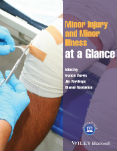-
10. List five symptoms of cauda equina syndrome.
Show Answer
Correct answer:
- Retention of urine
- Bowel incontinence
- Perineal paraesthesia
- Sexual dysfunction
- Bilateral leg weakness
(Signs include bilateral neurological abnormality in legs, perineal anaesthesia, lax anal tone, bilateral limitation in straight-leg raising)
See Chapter 26.
-
11. Which four muscles combine to make up the rotator cuff?
Show Answer
Correct answer:
- Infraspinatous
- Supraspinatus
- Subscapularis
- Teres minor
See Chapter 27.
-
12. Match up the following terms with the descriptions below: Popeye, adhesive capsulitis, 'light bulb' sign, painful arc.
(a) The appearance of the head of the humerus on an X-ray in the presence of a posterior dislocation of the shoulder.
(b) Pain on abduction of the arm between 60° and 120°.
(c) Enhancement of the biceps muscle on contraction due to rupture of the long head.
(d) Restriction of both active and passive shoulder movements, especially abduction and external rotation.
Show Answer
Correct answer:
Adhesive capsulitis
(a) The appearance of the head of the humerus on an X-ray in the presence of a posterior dislocation of the shoulder.
'Light bulb' sign
(b) Pain on abduction of the arm between 60° and 120°.
Painful arc
(c) Enhancement of the biceps muscle on contraction due to rupture of the long head.
Popeye
(d) Restriction of both active and passive shoulder movements, especially abduction and external rotation.
Adhesive capsulitis
See Chapter 28.
-
13. List the ossification centres of the elbow in correct order of appearance.
Show Answer
Correct answer:
Capitellum C
Radial head R
Internal (medial epicondyle) I
Trochlea T
Olecranon O
Lateral epicondyle L
See Chapter 29.
-
14. Name the eight bones of the wrist.
Show Answer
Correct answer:
- Trapezium
- Trapezoid
- Capitate
- Hamate
- Pisiform
- Triquetral
- Lunate
- Scaphoid
See Chapter 30.
-
15. Name the tendons responsible for the following.
(a) Flexion at the interphalangeal joint of the thumb.
(b) Flexion at the distal interphalangeal joint of the index finger.
(c) Flexion at the proximal interphalangeal joint of the ring finger.
(d) Flexion at the wrist joint.
(e) Extension of the interphalangeal joint of the thumb.
(f) Extension at the wrist joint.
(g) Extension of the fingers at the metacarpophalangeal joint.
(h) Extension of the fingers at the proximal interphalangeal joint.
Show Answer
Correct answer:
(a) Flexion at the interphalangeal joint of the thumb.
Flexor pollicis longus
(b) Flexion at the distal interphalangeal joint of the index finger.
Flexor digitorum profundus
(c) Flexion at the proximal interphalangeal joint of the ring finger.
Flexor digitorum superficialis
(d) Flexion at the wrist joint.
Flexor carpi ulnaris and radialis
(e) Extension of the interphalangeal joint of the thumb.
Extensor pollicis longus
(f) Extension at the wrist joint.
Extensor carpi radialis longus and brevis and extensor carpi ulnaris
(g) Extension of the fingers at the metacarpophalangeal joint.
Extensor digitorum communis
(h) Extension of the fingers at the proximal interphalangeal joint.
Lumbricals
See Chapters 31–33.
-
16. Match the following terms with the descriptions below: felon, paronychia, volar plate, mallet finger.
(a) Damage to the extensor tendon at the distal interphalangeal joint of the finger.
(b) Nail fold infection.
(c) Pulp space infection.
(d) Fibrous thickening of the interphalangeal joint capsule.
Show Answer
Correct answer:
(a) Damage to the extensor tendon at the distal interphalangeal joint of the finger.
Mallet finger
(b) Nail fold infection.
Paronychia
(c) Pulp space infection.
Felon
(d) Fibrous thickening of the interphalangeal joint capsule.
Volar plate
See Chapters 31–33.
-
17. The motor function of which nerve is responsible for the following movements in the hand: radial, ulnar, median?
(a) Finger abduction.
(b) Finger adduction.
(c) Thumb abduction.
(d) Thumb adduction.
(e) Wrist extension.
Show Answer
Correct answer:
(a) Finger abduction.
Ulnar
(b) Finger adduction.
Ulnar
(c) Thumb abduction.
Median
(d) Thumb adduction.
Ulnar
(e) Wrist extension.
Radial
See Chapters 31–33.
-
18. Match the following fractures with the descriptions below: Allen, Bennett, boxer, mallet.
(a) A fracture of the neck of the fifth metacarpal.
(b) A test to assess vascularity of the hand.
(c) A deformity to the finger at the distal interphalangeal joint as the result of a tendon/avulsuion injury.
(d) A fracture of the base of the first metacarpal.
Show Answer
Correct answer:
(a) A fracture of the neck of the fifth metacarpal.
Boxer
(b) A test to assess vascularity of the hand.
Allen
(c) A deformity to the finger at the distal interphalangeal joint as the result of a tendon/avulsuion injury.
Malletv
(d) A fracture of the base of the first metacarpal.
Bennett
See Chapters 31–33.

